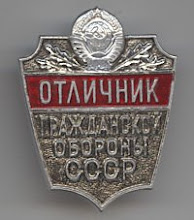Published in 1964, the Soviet translation is titled Убийство и сверхубийство. This is an earnest translation of the title, but the meaning in Russian is something like "Murder and Overmurder." Soviet readers were treated to an extensive introduction detailing Lapp's various ideological errors, but which concluded that the book would benefit Soviet readers by unveiling the self-apparent moral bankruptcy of the U.S. strategic nuclear posture. It explained that "the Soviet Union is opposed to nuclear war because it is confident in its strength, certain that its cause is just, certain that it will outperform imperialism in the world economic arena, while being steadfastly guided in its foreign policy by the great Leninist principle of peaceful coexistence of states with different social systems."
The edits made in the course of translation are certainly revealing. Take, for instance, this passage from Lapp's original (p. 140):
If the "semi-official estimates" are even approximately correct, the Soviet striking force was astonishingly far below that of the United States. Senator Stuart Symington conceded in 1961 that our intelligence agencies had vastly overestimated Soviet strength. (Among other things there was no "missile gap.") It became obvious that the U.S.S.R. had relied on a "minimum deterrent"--a force not designed to knock out our striking power but only large enough to destroy our cities and industries if it were attacked. In short, a second-strike force.
The Soviet translation renders this paragraph rather differently:
СССР явно полагается на "минимальные средства сдерживание"--на силы, предназначенные не для разгрома и уничтожения наших ударных сил, а для того, чтобы в ответ на нападение нанести сокрушительный удар по нашим городам и промышленности.
The USSR clearly relies upon "the minimum means of deterrence"--upon forces, intended not for the crushing defeat and destruction of our strike forces, but rather for the conveyance of a crushing blow to our cities and industry in answer to an attack.
The avoidance of any admission of Soviet weakness is typical of literature published in the USSR about the nuclear threat. Lapp's original paragraph has been changed here so that the Russian uses phrases common in Soviet propaganda of the Khrushchev years--particularly the phrase "в ответ на нападение нанести сокрушительный удар."
An edit I found particularly interesting, given my interest in civil defense, was to be found in this paragraph (p. 121):
But this technical question, as I have mentioned, is only one aspect of a vastly complex problem. Among many other aspects, one must consider the strategic effects. General Lyman L. Lemnitzer, chairman of the Joint Chiefs of Staff, welcomed the fallout shelter program as "an essential element" of our "deterrent"--that is, our military power. There can be no doubt that a large-scale shelter program would intensify the arms race, leading to Russian shelter-building and the pyramiding of more and bigger weapons by both sides. Shelters would then become part of a vicious cycle in strategic thinking.
Soviet readers, meanwhile, were treated to the following:
Но эта техчическая сторона вопроса, как я отметил, является только одним аспектом исключительно сложной проблемы. А мы прежде всего должны помнить об ее стратегических аспектах.
Бывшый председатель комитета начальников штабов генерал Л. Лемитцер охарактеровал программу строительства убежищ, обеспечивающих защиту от действия ядерных излучений, как "существенный элемент" нашей "сдерживающей силы", то есть нашей военной мощи. Не может быть никакого сомнения, что программа строительства убежищ в крупных масштабах вызовет гонку вооружений и приведет к увеличению количества и мощности оружия, создаемого обоими странами. Убежища тогда станут частью порочного круга в стратегическом мышлении.
But this technical part of the question, as I mentioned, is merely one aspect of an extremely complex problem. Most of all, we must consider the strategic aspects of it.
The former head of the committee of heads of staff General L. Lemnitzer characterized the program of the construction of shelters offering protection against the effect of nuclear radiation as "an essential element" of our "deterrent forces", that is, our military power. There can be no doubt, that the large-scale construction of shelters would intensify the arms race and lead to the increase in the number and power of weapons constructed by both countries. Shelters would then become a part of a perverse circle in strategic thought.
I am not quite sure what the deletion of the clause about Soviet shelter construction means. The Soviets had a much larger shelter program than the United States, but they were quick to emphasize that their civil defense program was qualitatively different from its American counterpart as it "served the people's interests" rather than the ambitions of "adventurists who seek to start a new world war." In any case, it's certainly an interesting editorial choice.

2 comments:
These edits are rather subtle. Do you think that they were done to serve a propaganda imperative, or were they done by the translators to make the document more palatable to whoever made the final decision on publication?
In short, both. Whoever was responsible for approving the published version stood to be punished if it contained any material considered damaging to the Party line, so it was in his interest to insure that it served the needs of propaganda.
Post a Comment